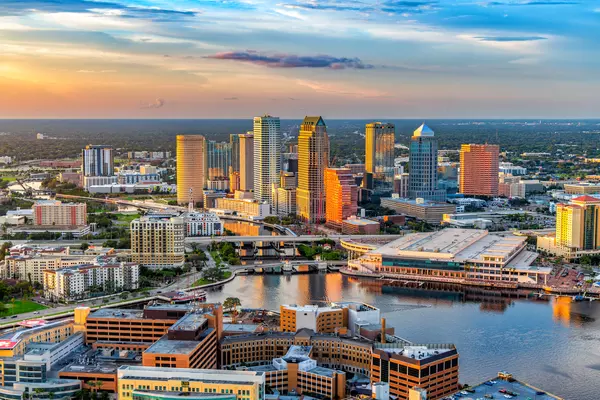MOST RECENT BLOGS
Why Everyone is Moving to St. Pete in 2025

In recent years, St. Petersburg, Florida, has become one of the most sought-after cities in the United States. As we step into 2025, the appeal of this Sunshine City continues to grow, drawing in new residents from all over the country. So, what makes St. Pete such a magnet for movers? Let’s explor
Read MoreWhat You NEED to Know Before Moving to St. Pete

St. Petersburg, affectionately known as St. Pete, is a slice of paradise on Florida’s Gulf Coast. With its perfect blend of urban charm and coastal living, it’s no wonder so many people are flocking here. But before you pack your bags, here are some essential things you need to know about life in
Read MoreExploring St. Petersburg: A Food Lover’s Paradise

St. Petersburg, Florida, is a culinary haven that combines fresh local ingredients, diverse cultural influences, and a vibrant dining scene. Whether you're a foodie on a mission or just looking for a memorable meal, the city offers something for everyone. Let’s dive into some of the must-visit din
Read MoreMy Top 5 Beaches to Visit in the St. Pete / Tampa Area

Top 5 Beaches to Visit in the St. Pete / Tampa Area The St. Pete / Tampa area is a slice of paradise, offering pristine beaches, breathtaking sunsets, and endless activities for all ages. Whether you’re planning a relaxing day by the water, an adventurous outing, or even dreaming of living near th
Read MoreDiscover the Charm of Old Northeast in St. Petersburg, FL

Nestled just north of downtown St. Petersburg, the Old Northeast neighborhood is a vibrant and historic area that offers a unique blend of classic architecture, scenic waterfront views, and a lively community atmosphere. Known for its lush tree-lined streets and charming brick roads, Old Northeast
Read MoreOctober Surge: Tampa Bay Home Sellers Fuel Housing Market Rebound

In October, last month’s home sellers not only listed their properties but also purchased new ones, boosting market demand, as shown in Realtor.com’s monthly housing report. September’s increase in new listings led to a rise in pending sales in October, with substantial gains in pending home sales
Read MoreExploring Historic Kenwood: A Charming Neighborhood in St. Petersburg, FL

Nestled just west of downtown St. Petersburg, Kenwood is a vibrant neighborhood known for its historic charm, diverse community, and beautiful tree-lined streets. This area offers a unique blend of residential tranquility and urban accessibility, making it a sought-after location for families, y
Read MoreThe Ultimate Guide to St. Petersburg's Best Neighborhoods

Welcome to St. Petersburg, a vibrant city where sunshine meets culture, and history blends seamlessly with modern living. Known for its beautiful waterfronts, thriving arts scene, and welcoming communities, St. Pete offers a lifestyle for everyone. Whether you're a young professional, a growing fam
Read MoreDiscover Coastal Living at Via Tivoli, Clearwater’s Hidden Gem

Nestled in the heart of Clearwater, the Via Tivoli community offers residents a slice of Mediterranean paradise right here in Florida. Known for its upscale architecture, resort-style amenities, and prime location, Via Tivoli is a haven for those seeking a mix of luxury and convenience. A Mediterra
Read MoreThe Benefits of Joining a Real Estate Team

In the competitive world of real estate, success often depends on the support and resources available to you. Joining a real estate team can be a game-changer for both new and experienced agents. Here are some compelling reasons why being part of a real estate team, like the Leisa Erickson Group,
Read MoreTampa Bay Experiences Rapid Growth in Build-to-Rent Homes Over Last Five Years

Over the last five years, Tampa Bay has emerged as a leading destination for build-to-rent (BTR) homes, reaching its peak success last year. Across the U.S., 32 metropolitan areas have completed their BTR inventories over the past five years, yet more than half currently have no new projects in th
Read More-

The Leisa Erickson Group proudly announces its remarkable achievement, securing the prestigious #6 position in Engel & Völkers Americas. This milestone is a testament to the team's unwavering commitment to excellence, exceptional client service, and unparalleled expertise in the real estate industr
Read More Unveiling the Success Story: 255 Dolphin Way!

At the heart of real estate lies the captivating tale of properties that quickly capture the imagination and hearts of eager buyers. This narrative often intertwines with exceptional marketing efforts, sparking a swift and exciting journey toward a successful sale. At the Leisa Erickson Group, we
Read More5 Tips For An Easier Thanksgiving Cleanup If You're Hosting For the First Time

Thanksgiving is easily anyone's favorite holiday of the year. With each bite of the glorious roast turkey, spoonfuls of delicious mashed potatoes, gravy, and cranberry sauce, and even a slice of pumpkin pie, we are transported closer to Christmas and the spirit of giving. But with a great fea
Read More5 Things You Didn't Think You Need To Ask About Before Buying A House

Need to dig deeper into the home you're looking to buy? Asking the right questions — and not just the kind that randomly pops into your head — can help you get as much information as you need to put together a competitive offer. Likewise, you will be able to save time, money, and potential heada
Read MoreHonoring All Who Served and The Many Advantages of VA Loans

Thank you, dear veterans, for your valor, strength, service, and dedication to protect us and keep us safe. Veterans sacrifice a lot to protect the country. And one way to show appreciation to them and their families is to make sure they know about the mortgage loan t
Read MoreUnderstanding Seller Concessions: What Are They and How Do They Work?

Whether you're a buyer looking for your first home or a seller preparing to put your property on the market, you’ve probably heard the term “concessions” in real estate. But what exactly does that refer to? Seller concessions, which are also called seller assist o
Read More5 Tips To Help Sell Your Home in The Fall

Sure, the spring season is the peak time to put a house on the market. But with the cooler weather, vibrant-colored trees and falling leaves, picking apples, carving pumpkins, and enjoying turkey dinners, there's plenty to look forward to when fall comes. One of them could be a successful home s
Read MoreBeware of These 5 Hidden Costs When Selling Your Home

If you've been thinking about listing your property for sale, you probably already know about the obvious costs associated with selling, such as real estate commissions and closing costs. However, there are also such things as “hidden” costs, which include a variety of smaller
Read More5 Questions Your Real Estate Agent Cannot Answer, and Why

Buying a home, especially if it's your first one, is a truly remarkable feat. You’ve probably got a thousand things to consider and a million questions in mind. Where am I gonna live? What type of house should I buy? Which neighborhood is the best for my lifestyle? How much should I put as a dow
Read More
Categories
Recent Posts











